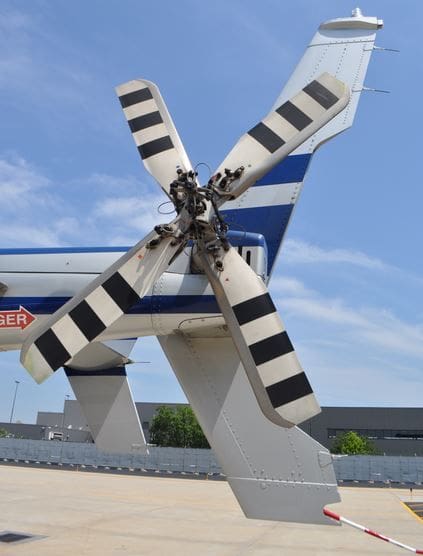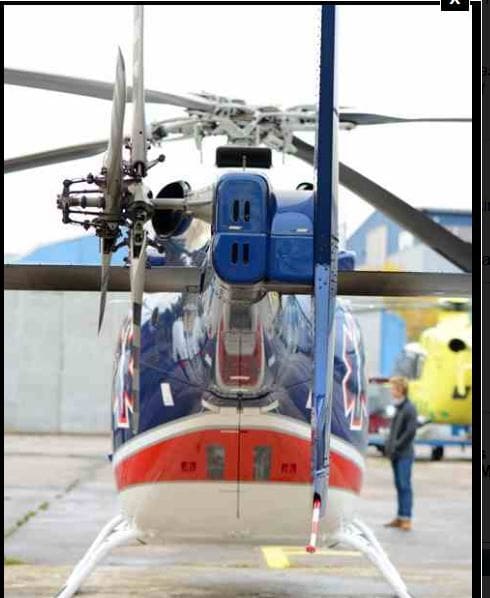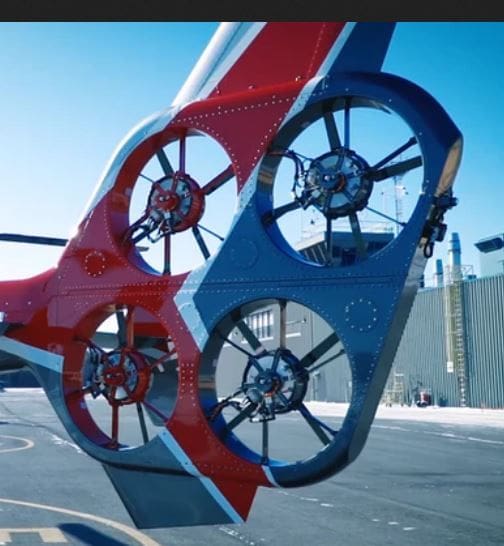Is Bell testing a multi-fenestron?
Thread Starter
skadi
Join Date: Mar 2009
Location: South Ridge
Posts: 61
Likes: 0
Received 0 Likes
on
0 Posts
Being fixed pitch fans, I wonder how the system will perform during autorotation where it will have to produce both positive and negative thrust in order to control yaw? I would imagine the negative thrust scenario might have a different subjective feel to the pilot because of inefficiencies associated with the fans running backwards.
Also, the system might feel a bit laggy as the fans change rpm. If any of you fly RC helis, the difference in response is night and day between a fixed-pitch rotor and a rotor with collective. Having 4 smaller fans, compared to one larger fan, might mitigate this issue a bit, however, because of the ability of the smaller fans to respond more quickly.
Also, the system might feel a bit laggy as the fans change rpm. If any of you fly RC helis, the difference in response is night and day between a fixed-pitch rotor and a rotor with collective. Having 4 smaller fans, compared to one larger fan, might mitigate this issue a bit, however, because of the ability of the smaller fans to respond more quickly.
Join Date: Apr 2009
Location: Canada
Posts: 27
Likes: 0
Received 0 Likes
on
0 Posts
Redundant generators. Each engine has one and you now have the no longer required tail rotor drive to use as a generator drive. I think three would be plenty. I assume each motor would have its own speed controller as well. A battery back up is probably unnecessary.
Would be interested to understand the difference in weight and CoG for this experimental configuration and what the increased surface area does to handling.
A fly by wire tail rotor system does allow for some interesting options for improved stability.
Bell could be onto a good idea, though it could look a bit sexier.
Still, not as fugly as fenestron
A fly by wire tail rotor system does allow for some interesting options for improved stability.
Bell could be onto a good idea, though it could look a bit sexier.
Still, not as fugly as fenestron

Assume you'd still have problems with running out of tail rotor power/authority in certain situations...?
I guess you don't even a long tail anymore and just have a stubby tail with 2 of these things either side of the stabiliser.
Most machines need a vertical fin for directional stability, and to stop it from bumping into the main rotor, it is on a boom that gets it away from under the disc. Minimum length that does the job.
Join Date: Dec 2014
Location: Ireland
Posts: 6
Likes: 0
Received 0 Likes
on
0 Posts
I'd imagine a system like this would be easy to configure so that the aircraft held a particular heading when no pedal input is introduced.
If the pedals now become switches to adjust the speed of the fans, surely it would be easy to connect this to the compass also.
If the pedals now become switches to adjust the speed of the fans, surely it would be easy to connect this to the compass also.
Join Date: Apr 1998
Location: Mesopotamos
Posts: 5
Likes: 0
Received 0 Likes
on
0 Posts
That video of the helicopter transitioning sideways along the runway is not convincing enough for me. I would really like to see the machine doing 360 pedal turns both ways while moving along the runway at that speed, now that would really be impressive.
Yes, you are quite correct in that the length of the tail increases the moment of the force. But in my suggestion you will have two of them which doubles the power however its not really that simplistic. The reason I suggested a shorter tail was more for the convenience in handling in tight spaces.
Curious SLF here. If you moved the tail rotor(s) closer to the main rotor wouldn't you have to put more power through them because of their shorter moment arm? Halve the distance and you would need to double the torque....
That video of the helicopter transitioning sideways along the runway is not convincing enough for me.
Have our expectations for new technologies become unrealistic?
Have our expectations for new technologies become unrealistic?
Bell has just flown the worlds first electric distributed fan anti torque system. This was not achieved on some unmanned drone, or a tiny ultralight helicopter. Test flights completed so far were not limited to just hovering or flights from a remote desert.
The Bell 429 EDAT is a full size piloted twin engine helicopter. Flights took place from a commercial airport and over populated areas. This remarkable achievement required full consideration in the design of pilot safety, surrounding population safety, and Transport Canada (Canuck FAA).
Have we become so used to seeing computer-generated graphics and small unmanned drones of unrealistic electric aircraft that many people now cannot appreciate a real advancement in aviation?
Of course EDAT is nowhere near ready for a production helicopter application. But what Bell has achieved should be congratulated and not dismissed. Especially at such a early stage of technology development.
Kudos to the Canucks!!!
Bell has just flown the worlds first electric distributed fan anti torque system. This was not achieved on some unmanned drone, or a tiny ultralight helicopter. Test flights completed so far were not limited to just hovering or flights from a remote desert.
The Bell 429 EDAT is a full size piloted twin engine helicopter. Flights took place from a commercial airport and over populated areas. This remarkable achievement required full consideration in the design of pilot safety, surrounding population safety, and Transport Canada (Canuck FAA).
Have we become so used to seeing computer-generated graphics and small unmanned drones of unrealistic electric aircraft that many people now cannot appreciate a real advancement in aviation?
Of course EDAT is nowhere near ready for a production helicopter application. But what Bell has achieved should be congratulated and not dismissed. Especially at such a early stage of technology development.
Kudos to the Canucks!!!
Last edited by CTR; 21st Feb 2020 at 14:18. Reason: Spelling
I'm usualy the one to pursue new technology but this is ridiculous. Probably just another thing they will stick to the 407 and 412, add another letter to the type and say it's now as modern as any other helicopter...
Join Date: Feb 2008
Location: Manitoba Canada
Age: 72
Posts: 223
Likes: 0
Received 0 Likes
on
0 Posts
(To my surprise) I like the looks of it .... and if they mold it in composites it could look even better .... also very slender from a rear-view compared to the original 4-blade TR which uses 2 sets of blades stacked side-by-side (pic below).
And to be able to stop the TR on the ground would be an advantage .... as well as a good sales and marketing tool for Bell to promote "safety" for passenger operations ..... very often people who sign those big helicopter checks are themselves not pilots so advertising safety to them has more sizzle than technical stuff .
Wish we knew the volts the electric motors require ..... if the same as the standard Bell starter-generator-battery it would simplify everything .... and if needed , they could simply mount an extra generator on the TR output quill on the main transmission ..... and for redundancy a larger battery
Just thinking out loud .... and in my opinion the whole electric TR system would be much simpler and dependable .... it is very rare for industrial electric generators or motors to fail.
.



And to be able to stop the TR on the ground would be an advantage .... as well as a good sales and marketing tool for Bell to promote "safety" for passenger operations ..... very often people who sign those big helicopter checks are themselves not pilots so advertising safety to them has more sizzle than technical stuff .
Wish we knew the volts the electric motors require ..... if the same as the standard Bell starter-generator-battery it would simplify everything .... and if needed , they could simply mount an extra generator on the TR output quill on the main transmission ..... and for redundancy a larger battery
Just thinking out loud .... and in my opinion the whole electric TR system would be much simpler and dependable .... it is very rare for industrial electric generators or motors to fail.
.



Isaac Newton might have something to say about that. Electric motor mounted on fuselage, drives rotor one way, fuselage must rotate the other way.
The only way around it was like the Djinn, using jet reaction motors on each blade tip. Interesting idea, but horrendously noisy.
The only way around it was like the Djinn, using jet reaction motors on each blade tip. Interesting idea, but horrendously noisy.
https://www.bellflight.com/products/bell-nexus
Hi
I guess, its Bell approach to incorporate a fenestron type tail rotor - without infringing Airbus patents.
Unfortunately, with fixed blades and variable speeds there might be some high pitch noises - which the original fenestron had also - but was overcome by the unequal spacing of the blades.
I´m also not sure, how well speed changes will cope witch quick demands of power?
And - with different speeds of the fans there will be different speeds of the airflow - while with a "conventional" fenestron/tailrotor (roughly) only the amount of air is altered.
Advantage is the removal of gears - but I´m not quite sure, if that will also be a weight benefit, cause wires which can take high amps as well as electric motors and additional generators will weight.
So I´m skeptical - don´t like the look either.
From an engineering point I really don´t see an advantage from four fans - compared to one bigger one.
I guess, its Bell approach to incorporate a fenestron type tail rotor - without infringing Airbus patents.
Unfortunately, with fixed blades and variable speeds there might be some high pitch noises - which the original fenestron had also - but was overcome by the unequal spacing of the blades.
I´m also not sure, how well speed changes will cope witch quick demands of power?
And - with different speeds of the fans there will be different speeds of the airflow - while with a "conventional" fenestron/tailrotor (roughly) only the amount of air is altered.
Advantage is the removal of gears - but I´m not quite sure, if that will also be a weight benefit, cause wires which can take high amps as well as electric motors and additional generators will weight.
So I´m skeptical - don´t like the look either.
From an engineering point I really don´t see an advantage from four fans - compared to one bigger one.
Join Date: Apr 2010
Location: USA
Posts: 850
Likes: 0
Received 0 Likes
on
0 Posts
As both an engineer and a helicopter pilot I think this is brilliant. It will be simpler, safer, lighter, more reliable, less noisy, and less expensive.
I am curious about the fan acceleration/deceleration curves. That seems a bit challenging, but clearly Bell would want this anti-torque mechanism to be at least as, if not more, responsive than existing methods.
Claims of zero tail rotor speed on the ground are interesting, but one wonders how this will be sorted out for operation on low friction surfaces like water, snow and ice (currently of significant concern to me every flying day this winter ).
).
I am curious about the exact weight trade-off. The tail intuitively looks lighter and sleeker than a gearbox, control rod, swash plate, pitch links and normal tail rotor. Wiring will not be any heavier than a drive shaft and probably lighter. But the weight of redundant generators and motor controllers located at the main gearbox is of interest. We could take a gander at the size of the motors if we had a little data: how much horsepower (or KW if your prefer) does the tail rotor require on this helicopter?
I am curious about the fan acceleration/deceleration curves. That seems a bit challenging, but clearly Bell would want this anti-torque mechanism to be at least as, if not more, responsive than existing methods.
Claims of zero tail rotor speed on the ground are interesting, but one wonders how this will be sorted out for operation on low friction surfaces like water, snow and ice (currently of significant concern to me every flying day this winter
 ).
).I am curious about the exact weight trade-off. The tail intuitively looks lighter and sleeker than a gearbox, control rod, swash plate, pitch links and normal tail rotor. Wiring will not be any heavier than a drive shaft and probably lighter. But the weight of redundant generators and motor controllers located at the main gearbox is of interest. We could take a gander at the size of the motors if we had a little data: how much horsepower (or KW if your prefer) does the tail rotor require on this helicopter?
they already have, why do you think they dropped the “helicopter” and became Bell flight.
https://www.bellflight.com/products/bell-nexus
https://www.bellflight.com/products/bell-nexus
All interesting stuff. It seems that helicopters of the current configuration may not be around for too long. Depends of course on the exact way the numbers work out but it would seem that a lot of the single points of failure of helicopters could be removed by the use of electric transmissions.
By the Way Electric Transmissions are not new.
https://en.wikipedia.org/wiki/Diesel...iesel_vehicles
"In 1914, world's first functional diesel–electric railcars were produced"
Last edited by jimjim1; 22nd Feb 2020 at 14:04.
Hi
I guess, its Bell approach to incorporate a fenestron type tail rotor - without infringing Airbus patents.
Unfortunately, with fixed blades and variable speeds there might be some high pitch noises - which the original fenestron had also - but was overcome by the unequal spacing of the blades.
I´m also not sure, how well speed changes will cope witch quick demands of power?
And - with different speeds of the fans there will be different speeds of the airflow - while with a "conventional" fenestron/tailrotor (roughly) only the amount of air is altered....e.
I guess, its Bell approach to incorporate a fenestron type tail rotor - without infringing Airbus patents.
Unfortunately, with fixed blades and variable speeds there might be some high pitch noises - which the original fenestron had also - but was overcome by the unequal spacing of the blades.
I´m also not sure, how well speed changes will cope witch quick demands of power?
And - with different speeds of the fans there will be different speeds of the airflow - while with a "conventional" fenestron/tailrotor (roughly) only the amount of air is altered....e.
NASA published some articles on electric distributed propulsion and the noise reduction benefits a few years back. In one article they described how operating multiple fans at different speeds reduces the apparent noise by spreading the frequency tones of the noise. Equivalent to playing a cord with multiple soft notes on a piano versus one loud note. I believe this is what Bell is trying to do with their EDAT.
Noise also increases with rotor tip speed, even in a duct. With electric motors driving fans, when thrust is not needed the fans can be reduced in speed, or even stopped. Not something that can be done with a conventional gear driven rotor.
As far as control response, as the Drive article notes, this is the reason for using 4 fans. Reducing individual fan inertia using multiple fans allows for rapid speed changes. If you watch some of the large quad drones maneuver, you will see this concept is already in use.
Thanks, my message was a bit too obtuse, I should have spelled it all out. I think I mentioned the nexus further above.
All interesting stuff. It seems that helicopters of the current configuration may not be around for too long. Depends of course on the exact way the numbers work out but it would seem that a lot of the single points of failure of helicopters could be removed by the use of electric transmissions.
By the Way Electric Transmissions are not new.
https://en.wikipedia.org/wiki/Diesel...iesel_vehicles
"In 1914, world's first functional diesel–electric railcars were produced"
All interesting stuff. It seems that helicopters of the current configuration may not be around for too long. Depends of course on the exact way the numbers work out but it would seem that a lot of the single points of failure of helicopters could be removed by the use of electric transmissions.
By the Way Electric Transmissions are not new.
https://en.wikipedia.org/wiki/Diesel...iesel_vehicles
"In 1914, world's first functional diesel–electric railcars were produced"
That doesn’t account for any eventual complexity required to certify the system. Keep in mind there are zero fly by wire civil certified helicopters in existence. Adding an FBW system like this would have flight critical software, redundancy requirements all along the routing of the tail boom and a requirement for no “common mode” failures. That generally means 4 identical fans and motors would not be easily qualified with in flight critical applications because they were not designed for such a purpose.
I bet it is heavier than the system it replaces by a large margin... increases susceptibility to common mode critical failures like software, lightning or EMI.... and substantially less efficient from a pure energy transfer perspective... lots of physics to combat to prove me wrong here.
im glad Bell is investing some money in commercial space though. This seems like a real project as opposed to the FCX1 thing they showed a few years ago... so that’s nice.



